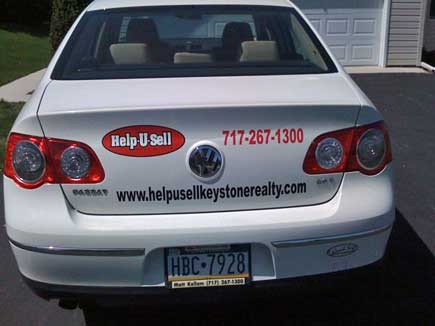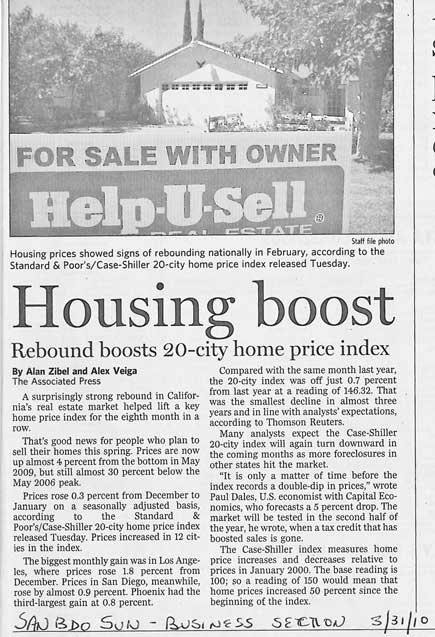Did You Stop Marketing? Or Did Marketing Change?
Help-U-Sell Marketing was always intense and usually direct mail oriented. You carefully chose your 15,000 +/- households and then hit them over and over with ETMS and Brag Cards, Free Weekly Lists and Save Thousands ads. The price tag for all of this was large but the pay off (if you chose your target market wisely) was huge. I talked with a former franchisee last month who described his operation as a machine. He set up his marketing and hired an assistant whose job was to handle the in bound seller inquiries and book him five listing appointments a day. That’s all.
And it worked wonderfully . . . until the housing market began to unravel in late 2005.
Suddenly sellers were faced with declining values, a weakening economy, cutbacks, layoffs and a tightening credit. Buyers weren’t buying and sellers couldn’t sell. The power of that wonderful marketing machine faltered too. By 2007, you could spend thousands of dollars each month on marketing and get very little return. Offices that hadn’t worked buyers, who didn’t develop a client base, who never learned how to talk with an expired listing or a for sale by owner — in other words: the ones who had relied on marketing driven listings alone to generate revenue — began to fail.
At the same time, the survivors began to emerge. Sharp, scrappy and determined, these brokers had the guts to look at the new reality with new eyes. The realized that, just as the market had changed, so had the consumer. Those brave souls who ventured into the market were doing their homework and doing it online. Buyers were in control and spent months on the Internet, looking hat houses before they were ready to ink a deal. Putting two and two together, smart Help-U-Sell brokers realized that marketing to sellers was no longer efficient and went after buyers where the buyers were hanging out: the Internet. They invested in websites, search engine optimization, social networking, blogs and more.
They also went back to school. They remembered that every real estate transaction was about solving problems, a buyer’s problems and a seller’s problems. But the problems had changed dramatically from the days when five listing appointments a day could make you a star. Buyers were having difficulty getting financing and sellers were upside down. We had to learn mortgage lending to identify those buyers we could help and we had to learn short sales to minimize the damage to our sellers. Help-U-Sell brokers became navigators, pointing the way for buyers and sellers to make it through the new maze of market realities.
Direct mail marketing didn’t die — it just went on hiatus. We used the break to learn how to work with new tools to generate leads and, with perfect timing, new Help-U-Sell websites bloomed on the Internet.
Today, the real estate market is starting to wake up. I know this because investors are in an absolute feeding frenzy and have been for almost a year. Investors always set the bottom of the market — when they come out to play up ticks in activity and value are not far away. Just as the market improves, we also have to start ratcheting up our marketing. Brag cards are a great way to start — even if they are hung on doorknobs rather than delivered in mailboxes. A carefully targeted Penny Saver or super market mailer campaign might also make good sense. Remember: we survived the downturn by adapting. We changed the way we marketed. We will flourish in the upturn by doing the same thing.
The Internet was (and continues to be) all about reaching buyers. It’s time to start reaching sellers, too — and nobody knows how to do that better than we do.
Reporting in OMS
Just a reminder: This is ‘Learn How to Report Using OMS’ week. Every day at 9am, Pacific (12 noon, Eastern), we’re doing 15 minute webinars on how to use the new system to report transactions. I wanted to do this because I kept talking to brokers who weren’t reporting because they just hadn’t taken the time to learn how (!). Others were sending in spreadsheets and sometimes even hand scrawled notes (!). Here’s why it’s important to report using OMS:
- It preserves your information so that it is available for office management reports. Today we only have a couple of reports that mostly list what’s been done. As we move forward, however, more and better reports with valuable KPI information will be available and will become a strong tool in monitoring the progress of your business and planning.
- It’s quicker, easier and more accurate than any other method you might try.
- It is required. Really: it is the only acceptable method of reporting.
- It’s fun! Ok, maybe I exaggerate.
There are a couple ways to learn how to do this, the easiest being: attend one of the webinars this week. If that doesn’t fit your schedule, a guide is on the Download Library under Technology Summit Documents, in the OMS Manual folder. It is the ‘Sales Module’.
You received an invitation in your email this past weekend with the webinar login information. If you can’t find it, contact anyone at Corporate or email support@helpusell.com and we’ll get you set up.
(In case you missed it: OMS stands for Office Management System.)
Spotted in the San Bernardino Sun Business Section
What Consumers Wanted and What They Want Now
I got licensed back in the Pleistocene Era, when dinosaurs roamed the earth: 1976.
Consumers had very little information about real estate, and it wasn’t just MLS-type property information they were lacking. We had five or six television stations (channels in the UHF range – above channel 12 – were just starting to appear) and so what became a major source of information for many was just getting cranked up. FM radio was mostly college stations and public broadcasting — AM was king — but there was no news or talk radio. Not only was there no Internet, there were no PCs. Information traveled at the speed of sludge and John Q Public had a very limited range of understanding about real estate and about many other things.
REALTORS held the keys to the kingdom: the MLS. The only way consumers got to information about property for sale was through us. And though there were a few FSBOs, most were willing to pay traditional percentage commissions to gain access to the information. Funny, though: with an average sale price of $65,000, a commission of $3,600 — though big — didn’t irritate as much as today, when selling the same house would probably cost in the neighborhood of $15,000.
Sellers expected us to do everything. They wanted to sign the listing agreement and disappear back into their lives, letting their agents take over the process and magically produce a ready willing and able buyer. I spent much of my agent-time keeping my sellers (buyers too) informed about the process: what’s coming next, what to expect, what problems might come up and how we’ll deal with them, etc. They were so grateful to have my understanding of how real estate worked at their disposal.
You spent a lot of time with buyers just narrowing the field of their wants and needs. They needed to see lots of houses to get down to the style, size and location of the perfect house for them and so showing 15, 20, 30 houses over the course of several weekends was not unusual. They had no way of ‘seeing’ property unless you put them in the car, drove them over and escorted them through. The best buyer was always the transferee, who often came with home buying assistance from their employer and usually had a very limited time to find the perfect home. With the transferee you had the chance of meeting a buyer on Friday and writing an offer for them on Sunday — and that was reason to celebrate!
Today, consumers have ALL the information at their fingertips. The listing information they can view online is almost identical to what we can see, and tools like Listingbook, Zillow and Trulia make it possible for them to easily manage their own home search process . . . until they need a door opened. More than that, consumers today can get information about every step of the home buying and selling process by typing a search string in Google. The air waves — radio, television and Internet — are loaded with information about property transactions and there are whole television channels devoted to real estate.
Sellers look to us to plug them into the marketing resources that exist: MLS, our website, syndication to as many other aggregators as possible. They also look to us to spread the word about their property locally and to promote it to our Sphere of Influence. The goal is the same as it’s always been: exposure. Today, because the paths to exposure are so well developed, the task is more management of marketing than creation of marketing.
More than exposure, Sellers today look to us to solve their property problem. Whether they’re upside down, facing foreclosure or just trying to hang on to as much of their equity as possible, our role is to help them map a course that gets them as close to their goals as possible. Today that often means minimizing the pain. Really: 150 years ago, when I was selling real estate, simply dropping the new listing in MLS and letting the industry find a buyer in a reasonable period of time was fine. Everybody moved and everybody was happy. Today it’s much more about using your knowledge to accomplish the best possible outcome for your clients, and your knowledge has to always be growing. That’s why, as James Brown said, it’s important that we all stay in school!
Buyers want to do much of their searching on their own. They want to spend hours on the Internet looking at listings, saving and eliminating them. They want to drive by before deciding whether they want to see the inside. They don’t want to be held captive in the back seat of your car while you show them house after inappropriate house. The value we can bring to them is in giving them the best tools to help them do that self-directed searching, making it easy for them to get quick answers when they need them, and in anticipating problems before they occur. I keep saying this: Listingbook is your best friend when it comes to doing all of this.
The job of REALTOR today is very different than it used to be. It’s not that we DO LESS than we used to do, it’s that our clients DO MORE. It’s also that the job has become more specialized and focused. The one thing that hasn’t changed is the way ordinary real estate brokers charge for their services. That’s still stuck in the Pleistocene Era. The tough market of the last few years is like an Ice Age and as with all Ice Ages, the end result will be extinction for certain species. Not to worry. As the ice recedes, newer, better, stronger, more adaptable species emerge and dominate. That’s us.




